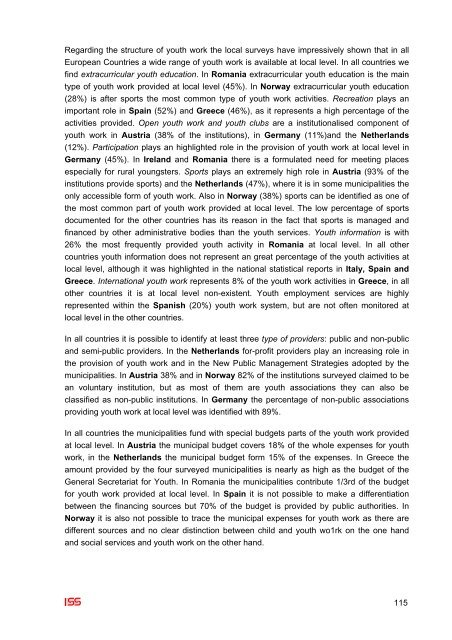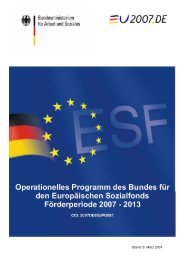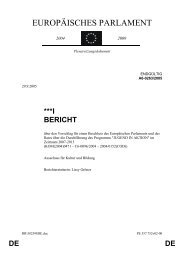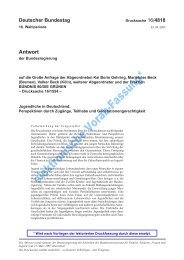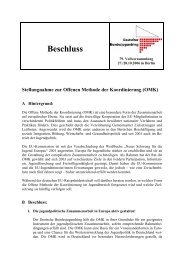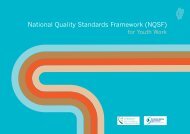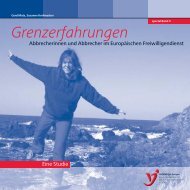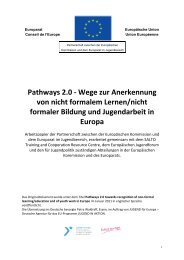6 Country Reports on Youth Work - Jugendpolitik in Europa
6 Country Reports on Youth Work - Jugendpolitik in Europa
6 Country Reports on Youth Work - Jugendpolitik in Europa
Create successful ePaper yourself
Turn your PDF publications into a flip-book with our unique Google optimized e-Paper software.
Regard<strong>in</strong>g the structure of youth work the local surveys have impressively shown that <strong>in</strong> all<br />
European Countries a wide range of youth work is available at local level. In all countries we<br />
f<strong>in</strong>d extracurricular youth educati<strong>on</strong>. In Romania extracurricular youth educati<strong>on</strong> is the ma<strong>in</strong><br />
type of youth work provided at local level (45%). In Norway extracurricular youth educati<strong>on</strong><br />
(28%) is after sports the most comm<strong>on</strong> type of youth work activities. Recreati<strong>on</strong> plays an<br />
important role <strong>in</strong> Spa<strong>in</strong> (52%) and Greece (46%), as it represents a high percentage of the<br />
activities provided. Open youth work and youth clubs are a <strong>in</strong>stituti<strong>on</strong>alised comp<strong>on</strong>ent of<br />
youth work <strong>in</strong> Austria (38% of the <strong>in</strong>stituti<strong>on</strong>s), <strong>in</strong> Germany (11%)and the Netherlands<br />
(12%). Participati<strong>on</strong> plays an highlighted role <strong>in</strong> the provisi<strong>on</strong> of youth work at local level <strong>in</strong><br />
Germany (45%). In Ireland and Romania there is a formulated need for meet<strong>in</strong>g places<br />
especially for rural youngsters. Sports plays an extremely high role <strong>in</strong> Austria (93% of the<br />
<strong>in</strong>stituti<strong>on</strong>s provide sports) and the Netherlands (47%), where it is <strong>in</strong> some municipalities the<br />
<strong>on</strong>ly accessible form of youth work. Also <strong>in</strong> Norway (38%) sports can be identified as <strong>on</strong>e of<br />
the most comm<strong>on</strong> part of youth work provided at local level. The low percentage of sports<br />
documented for the other countries has its reas<strong>on</strong> <strong>in</strong> the fact that sports is managed and<br />
f<strong>in</strong>anced by other adm<strong>in</strong>istrative bodies than the youth services. <strong>Youth</strong> <strong>in</strong>formati<strong>on</strong> is with<br />
26% the most frequently provided youth activity <strong>in</strong> Romania at local level. In all other<br />
countries youth <strong>in</strong>formati<strong>on</strong> does not represent an great percentage of the youth activities at<br />
local level, although it was highlighted <strong>in</strong> the nati<strong>on</strong>al statistical reports <strong>in</strong> Italy, Spa<strong>in</strong> and<br />
Greece. Internati<strong>on</strong>al youth work represents 8% of the youth work activities <strong>in</strong> Greece, <strong>in</strong> all<br />
other countries it is at local level n<strong>on</strong>-existent. <strong>Youth</strong> employment services are highly<br />
represented with<strong>in</strong> the Spanish (20%) youth work system, but are not often m<strong>on</strong>itored at<br />
local level <strong>in</strong> the other countries.<br />
In all countries it is possible to identify at least three type of providers: public and n<strong>on</strong>-public<br />
and semi-public providers. In the Netherlands for-profit providers play an <strong>in</strong>creas<strong>in</strong>g role <strong>in</strong><br />
the provisi<strong>on</strong> of youth work and <strong>in</strong> the New Public Management Strategies adopted by the<br />
municipalities. In Austria 38% and <strong>in</strong> Norway 82% of the <strong>in</strong>stituti<strong>on</strong>s surveyed claimed to be<br />
an voluntary <strong>in</strong>stituti<strong>on</strong>, but as most of them are youth associati<strong>on</strong>s they can also be<br />
classified as n<strong>on</strong>-public <strong>in</strong>stituti<strong>on</strong>s. In Germany the percentage of n<strong>on</strong>-public associati<strong>on</strong>s<br />
provid<strong>in</strong>g youth work at local level was identified with 89%.<br />
In all countries the municipalities fund with special budgets parts of the youth work provided<br />
at local level. In Austria the municipal budget covers 18% of the whole expenses for youth<br />
work, <strong>in</strong> the Netherlands the municipal budget form 15% of the expenses. In Greece the<br />
amount provided by the four surveyed municipalities is nearly as high as the budget of the<br />
General Secretariat for <strong>Youth</strong>. In Romania the municipalities c<strong>on</strong>tribute 1/3rd of the budget<br />
for youth work provided at local level. In Spa<strong>in</strong> it is not possible to make a differentiati<strong>on</strong><br />
between the f<strong>in</strong>anc<strong>in</strong>g sources but 70% of the budget is provided by public authorities. In<br />
Norway it is also not possible to trace the municipal expenses for youth work as there are<br />
different sources and no clear dist<strong>in</strong>cti<strong>on</strong> between child and youth wo1rk <strong>on</strong> the <strong>on</strong>e hand<br />
and social services and youth work <strong>on</strong> the other hand.<br />
115


